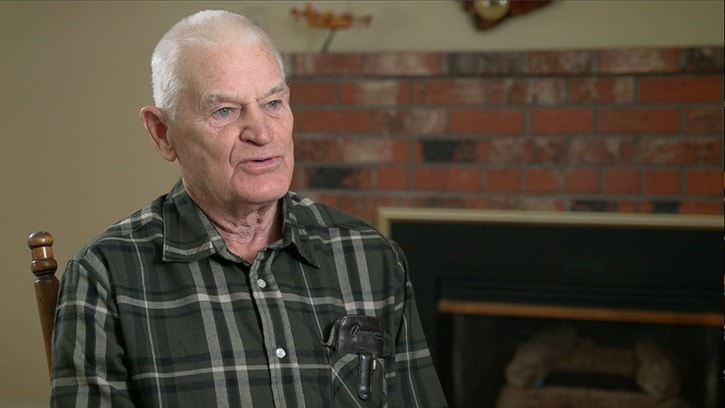Lou Lessard was 29 and a frontend foreman responsible for receiving and positioning steel beams in the construction of the new Second Narrows Bridge. It was a clear June day in 1958 and a 55-ton piece of steel was arriving by flatcar to Lessard and his 10-man crew.
"That's not big for us because we had some up to 100 tonnes," says the now 87 year old, from his home in Langley.
"So we were hooking on the piece of steel just a little off the flatcar, then all at once, the bridge just fell down from underneath our feet."
 Lessard and 78 of his colleagues plunged more than 100 feet into Burrard Inlet, with tools, steel beams and a train car along with them. There wasn't time to think — He was working one moment and falling the next.
Lessard and 78 of his colleagues plunged more than 100 feet into Burrard Inlet, with tools, steel beams and a train car along with them. There wasn't time to think — He was working one moment and falling the next.
"I ended up at the bottom of the water, with a broken arm and a broken leg."
Lessard and the other workers were wearing life jackets but his was ripped off on impact with the water.
"But I managed to rescue myself. I was on the bottom and I was kind of shocked and the water was all dirty because when the steel hit the bottom, that kind of mixed up the mud there. It was dark. I couldn't see or know what was happening. Then, all at once I can see daylight coming through the mud in the water — the sun.
"Then I came up above the water. Then I grabbed a couple planks and saved myself and when I looked around I see what has happened with all those guys there, bleeding, getting hurt, bodies floating on the water and the whole bridge down, partly underneath the water."
'I was lucky'
Eighteen men died in the collapse and a recovery diver died later afterwards.
"I was lucky. I was at the edge of the bridge that fell free from the wreckage. Otherwise I would have been dead too," says Lessard.
He spent several weeks in hospital, mending his shattered femur.
"They kept me for a couple weeks on tension, with some weight hanging on my foot, to keep the leg from the bone, from crushing each other. And after a couple of weeks when they thought I had an infection, they opened up the leg on the top and they put a steel pin from the hip to the knee inside the bone. Then they tied all the biggest pieces of bone together around the shaft there and never put a cast or nothing. They just left it open so they can watch it."
 He had internal injuries, cuts and bruises as well as a broken arm.
He had internal injuries, cuts and bruises as well as a broken arm.
"But that's nothing, an arm," he says.
Lessard had the pin in his leg until the following July, 13 months after the collapse. But long before he had the piece of steel removed, he was moving steel again, back at work on the renewed effort to build a Second Narrows Bridge, only four or five months after the tragedy.
Was he scared?
"Not a bit."
The engineering issues with the old bridge were identified and corrected and as work started up again, Lessard says he had full confidence in engineers and their plan.
Lessard will attend a ceremony on Friday afternoon, commemorating the collapse at the Ironworkers Memorial Monument, on the Vancouver side of the bridge now known as the Ironworkers Memorial Second Narrows Crossing. Over the decades, Lessard has only missed the annual event when he was out of town, building more steel structures: pulp mills, schools, mines, towers and bridges.
'We made a promise'
He goes to remember his fallen colleagues, his brothers.
"Those guys, they were working for me and they were brothers in the union there. I knew their families. I knew their wives and the kids.
"And when they were single — I was single at the time — going out together. And we promised those guys that we were never going to forget about them. We are always going to remember them and their families, for the sacrifice that they did. That is important to me. We made a promise.
"That could have been me dead there and after I recovered, I had four kids, and I have a bunch of grandchildren and great grandchildren. There would have been none of that."
